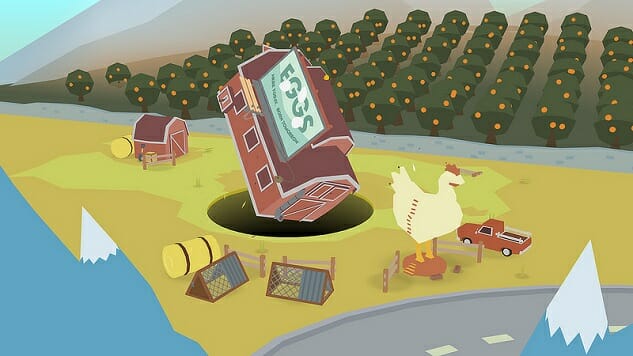Donut County: It’s Time to Make the Donuts (and City-Devouring Holes)

I don’t trust donuts without holes. You can take all those jelly and crème-filled monstrosities and just bury them deep inside the earth, for all I care. That void in the center is a crucial part of what makes donuts so good, ensuring that they’re easy to hold on to and perfect for dunking or eating on the go, while also giving your palette a brief, much-needed rest right when all that sugar and cake starts to become too much. There are no donuts without holes, for a donut without a hole is something else entirely.
So, then, what does that make a donut hole? And what does any of this have to do with Donut County, which is a videogame, and not some mythical land full of everybody’s favorite breakfast treat?
A donut hole is exactly that: a donut hole. It is its own unique type of delicious snack. And the equally unique Donut County, meanwhile, is entirely about holes of the non-donut variety, and the destruction they can wreak upon a southwestern community when deployed with malice by a clan of scheming raccoons. If you’ve ever wanted to swallow up a pastel desert town full of blocky, adorable animals with sass and quirks aplenty, Donut County is the game for you.
Here’s how it works: the hole starts small on each level. You move it beneath objects and watch them tumble down into the void, and the hole grows incrementally bigger with everything that passes through it. Eventually you’ll be able to suck up objects that were far too large at first, from characters and vehicles to entire buildings. By the end of each level pretty much everything will be cleared out, leaving a blank slate for the new raccoon civilization to come.
It’s not really a game that tries to challenge the player. Most levels are fairly straightforward—start with the smaller objects and gradually work your way up as your hole widens. There are some light puzzle elements—you’ll have to fill your hole up with fire or water to trigger specific reactions on some levels, or use the hole to interact with levers or other objects. These are all readily apparent and easy to understand, making it perhaps a stretch to even call them “light puzzle elements.” Only once did I have any issues with a level, and it was a matter of getting the timing down more than struggling for a solution. Donut County is easy, and short, and that’s fine, because it’s also fun and charming, and also because the main reason to play is what happens between the levels, and not during them.
Almost three months ago I wrote this tweet after playing twenty minutes of Donut County at E3:
-

-

-

-

-

-

-

-

-

-

-

-

-

-

-

-

-

-

-

-

-

-

-

-

-

-

-

-

-

-

-

-

-

-

-

-

-

-

-

-








































